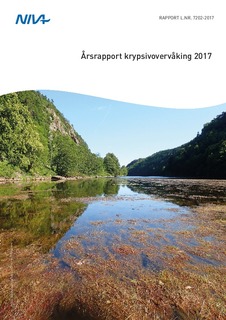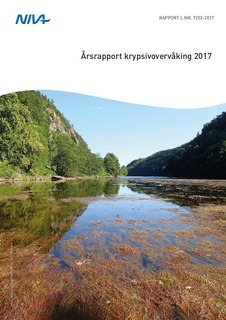| dc.contributor.author | Moe, Therese Fosholt | |
| dc.contributor.author | Demars, Benoît Olivier Laurent | |
| dc.contributor.other | Moe, Therese Fosholt - Project manager | |
| dc.date.accessioned | 2018-01-29T10:00:09Z | |
| dc.date.available | 2018-01-29T10:00:09Z | |
| dc.date.created | 2018-01-25T08:55:45Z | |
| dc.date.issued | 2017 | |
| dc.identifier | 7202 | |
| dc.identifier.isbn | 978-82-577-6937-6 | |
| dc.identifier.issn | 1894-7948 | |
| dc.identifier.uri | http://hdl.handle.net/11250/2480195 | |
| dc.description.abstract | Undersøkelser fra fire år med overvåking av krypsiv ved 18 stasjoner i Mandalselva, Otra og Tovdalselva viser at ingen av de undersøkte faktorene alene kan forklare de store forskjellene i krypsivbiomasse mellom stasjoner med problemvekst sammenliknet med referanselokalitetene. Det ser ut til at det er en kombinasjon av kjemiske og fysiske påvirkninger som over tid har ført til utviklingen av de massebestandene av krypsiv vi ser i dag. Det er også tydelig at kraftproduksjonen ikke bare påvirker de hydrologiske forholdene i disse elvene, men også endrer vannkjemien, med høyere konsentrasjoner ammonium og CO2, to viktige faktorer for plantevekst. For bedre å forstå og forutsi utviklingen av problemvekst av krypsiv anbefales det at man framover analyserer økosystemfunksjoner og prosesser som virker i kombinasjon og over tid. På denne måten kan man bedre forebygge problemvekst og tilpasse tiltak som er mer kostnadseffektive og reduserer gjenveksten. | nb_NO |
| dc.description.abstract | Four years of monitoring Juncus bulbosus and parameters influencing plant growth at 18 sites in the three rivers Mandalselva, Otra and Tovdalselva show that none of the investigated parameters alone can explain the large differences in biomass between sites with nuisance growth compared to reference sites. Combinations of water chemistry and pore water chemical parameters also cannot explain this difference. The conclusion is therefore that a combination of chemical and physical factors over time has led to the development of the nuisance biomasses we observe today. It is also clear that hydropower not only affects the hydrological regime in these rivers, but also changes the water chemistry; with higher concentrations of the major plant nutrients ammonium and CO2. To better understand and predict the development of nuisance growth in the future, we recommend analyzing ecosystem functions and processes that work in combination and over time. This way, we can better prevent the development of nuisance growth, and also adapt the measures implemented to increase the cost-effectiveness and reduce regrowth after removal. | nb_NO |
| dc.description.sponsorship | Krypsivprosjektet på Sørlandet (KPS) | nb_NO |
| dc.language.iso | nob | nb_NO |
| dc.publisher | Norsk institutt for vannforskning | nb_NO |
| dc.relation.ispartof | NIVA-rapport | |
| dc.relation.ispartofseries | NIVA-rapport;7202 | |
| dc.rights | Navngivelse-Ikkekommersiell-DelPåSammeVilkår 4.0 Internasjonal | * |
| dc.rights.uri | http://creativecommons.org/licenses/by-nc-sa/4.0/deed.no | * |
| dc.subject | Elver | nb_NO |
| dc.subject | Rivers | nb_NO |
| dc.subject | Problemvekst | nb_NO |
| dc.subject | Nuisance growth | nb_NO |
| dc.subject | Overvåking | nb_NO |
| dc.subject | Monitoring | nb_NO |
| dc.subject | Krypsiv | nb_NO |
| dc.subject | Bulbous rush | nb_NO |
| dc.title | Årsrapport krypsivovervåking 2017 | nb_NO |
| dc.title.alternative | Monitoring bulbous rush, yearly report 2017 | nb_NO |
| dc.type | Research report | nb_NO |
| dc.description.version | publishedVersion | nb_NO |
| dc.rights.holder | Norsk institutt for vannforskning / Norwegian Institute for Water Research | nb_NO |
| dc.subject.nsi | VDP::Matematikk og naturvitenskap: 400 | nb_NO |
| dc.subject.nsi | VDP::Mathematics and natural scienses: 400 | nb_NO |
| dc.source.pagenumber | 89 | nb_NO |
| dc.source.issue | 7202 | nb_NO |
| dc.identifier.cristin | 1551473 | |
| dc.relation.project | 16172 | nb_NO |
| cristin.unitcode | 7464,30,19,0 | |
| cristin.unitname | Ferskvannsøkologi | |
| cristin.ispublished | true | |
| cristin.fulltext | original | |


